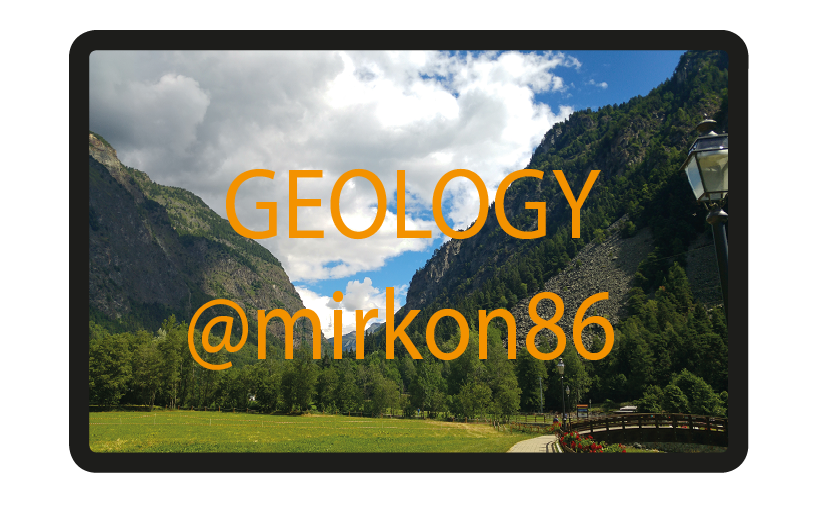

Ciao a tutti! Bentornati nel mio profilo Steemit. Di sicuro tutti noi abbiamo sentito parlare delle meteoriti e probabilmente, in qualche caso fortunato, viste cadere. In questo post parleremo di questi affascinanti corpi spaziali e di tutte le loro caratteristiche principali, in modo da poterle riconoscerle in caso ne troviate una. Buona lettura! :)
Che cosa sono le meteoriti?
"Mamma ho visto una stella cadente!" Chissà quanti di voi hanno pronunciato queste esatte parole. In cielo, nelle notti non disturbate dalle luci della città è possibile vedere "queste stelle cadenti". Le stelle cadenti, ovviamente, non sono vere stelle come magari si poteva credere da bambini, ma sono roccia mista a polvere che viaggiano nello spazio e che bruciano quando sono vicini all'atmosfera. Scientificamente, quando queste stelle cadenti sono nello spazio sono chiamate meteoroidi, mentre quando sono a contatto con l'atmosfera ed iniziano a bruciare si chiamano meteore. Durante il loro processo di fusione, però, bruciando per attrito, iniziano a distruggersi nell'atmosfera e a dissolversi in essa. Non è detto che queste meteore brucino nella loro totalità durante la loro discesa. Infatti, esiste la possibilità che superata l'atmosfera, parte della meteora resti, raggiungendo poi la superficie terrestre. Questo resto sarà quello che noi chiameremo meteorite.

Hello to everyone! Welcome back to my Steemit profile. For sure we have all heard of the meteorites and probably, in some lucky cases, seen fall. In this post we will talk about these fascinating space bodies and all their main features, so you can recognize them in case you find one. Enjoy the reading! :)
What are meteorites?
"Mom, I saw a shooting star!" Who knows how many of you have pronounced these exact words. In the sky, in the nights not disturbed by the lights of the city it is possible to see "these falling stars". Falling stars, of course, are not true stars as one might believe as children, but they are rocks mixed with dust that travel in space and that burn when they are close to the atmosphere. Scientifically, when these shooting stars are in space they are called meteoroids, while when they are in contact with the atmosphere and start to burn they are called meteors. During their fusion process, however, burning by friction, they begin to destroy themselves in the atmosphere and dissolve in it. It is not said that these meteors burn in their entirety during their descent. In fact, there is the possibility that the atmosphere is overcome, part of the meteor remains, then reaching the earth's surface. This rest will be what we will call meteorite.
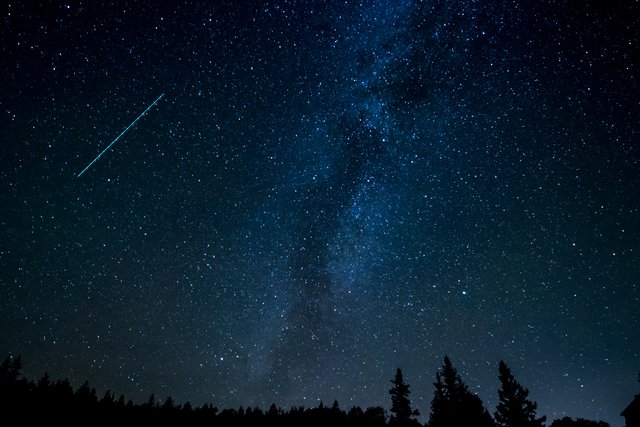
Stella cadente / Shooting star
LINK:https://static.pexels.com/photos/631477/pexels-photo-631477.jpeg
La classificazione delle meteoriti: partiamo dalle sideriti!
Come potevate immaginare, i meteoriti non sono tutti uguali, ma hanno una loro differenziazione. Questa diversificazione è dovuta alla differente composizione chimica e dalla presenza di particolari strutture che non si trovano in tutte le meteoriti. Esse si suddividono in tre principali classi: le sideriti, le sideroliti e le aeroliti. Come ho scritto nel titolo del paragrafo, partiamo con le sideriti!
Le sideriti tra tutte le meteoriti sono sicuramente le più evidenti poiché sono composte prevalentemente in ferro e in nichel. Solo alla vista risultano essere molto "metalliche" e piuttosto pesanti. Tipicamente nelle sideriti ci sono alcune strutture che si chiamano figure di Widmanstatten. Sono figure triangolari con angoli precisi che definiscono il meteorite come di origine extraterrestre. Sulla Terra non esistono queste figure in nessun'altra roccia. Le sideriti nel totale dei meteoriti, risultano essere solo il 10 %, ma in generale sono quelle che vengono trovate più facilmente date le loro particolarità. Inoltre, hanno una loro suddivisione in funzione del contenuto in nichel e dalla presenza delle figure di Widmanstatten.
Eccole qui di seguito:
OTTAEDRITI
Hanno figure di Widmanstatten e un'intercrescita di kamacite e taenite, le quali sono leghe di ferro e nichel. La taenite è la fase ricca in nichel (circa il 30-70% di Ni), mentre la kamacite quella ricca in ferro (circa il 5-10% di Ni).
ATAXITI
Non hanno le figure di Widmanstatten e sono fatti principalmente di taenite. Il nichel può raggiungere il 18 %.
ESOADRITI
Sono presenti evidenti figure di Widmanstatten e di linee di sfaldatura chiamate linee di Neumann. Le linee di Neumann sono sottili striature che rappresentano linee di sfaldatura. Le esoadriti sono quasi totalmente composte da kamacite (5% di Ni).
Meteorites classification: let's start from the siderites!
As you could imagine, meteorites are not all the same, but have their differentiation. This diversification is due to the different chemical composition and the presence of particular structures that are not found in all meteorites. They are subdivided into three main classes: siderites, siderolites and aerolites. As I wrote in the title of the paragraph, let's start with the siderites!
The siderites among all the meteorites are certainly the most obvious because they are composed mainly of iron and nickel. Only at the sight they appear to be very "metallic" and rather heavy. Typically in the siderites there are some structures that are called figures of Widmanstatten. They are triangular figures with precise angles that define the meteorite as having an extraterrestrial origin. On Earth there are no such figures in any other rock. Siderites in the total of meteorites, are only 10%, but in general they are those that are found more easily given their particularities. In addition, they are subdivided according to the nickel content and the presence of the Widmanstatten figures.
Here they are:
OCTAHEDRITES
They have Widmanstatten figures and an intercrescence of kamacite and taenite, which are iron and nickel alloys. Taenite is rich in nickel (about 30-70% of Ni), while kamacite is rich in iron (about 5-10% of Ni).
ATAXITES
They do not have the Widmanstatten figures and are mainly made of taenite. Nickel can reach 18%.
HEXAHEDRITES
There are evident figures of Widmanstatten and of flaking lines called Neumann lines. Neumann lines are thin streaks that represent flaking lines. The hexahedrites are almost totally composed of kamacite (5% of Ni).
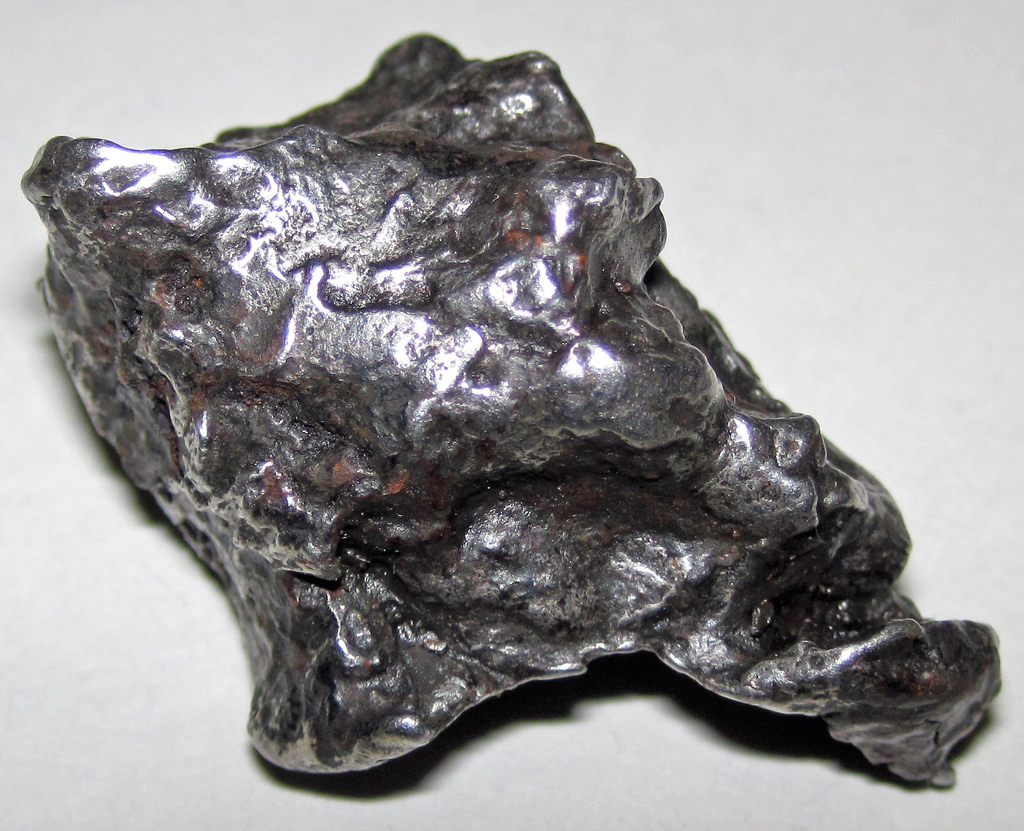
Ottaedrite / Octahedrites
LINK:https://c1.staticflickr.com/9/8398/29590505330_67c786c29f_b.jpg
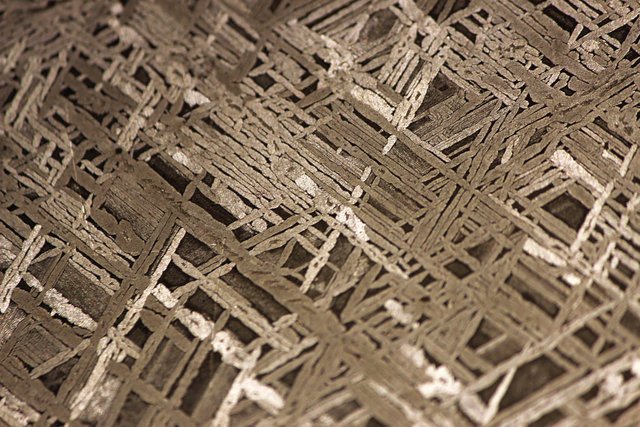
Figure di Widmanstatten / Widmanstatten figures
LINK:https://c1.staticflickr.com/4/3910/14961451761_3391169952_b.jpg
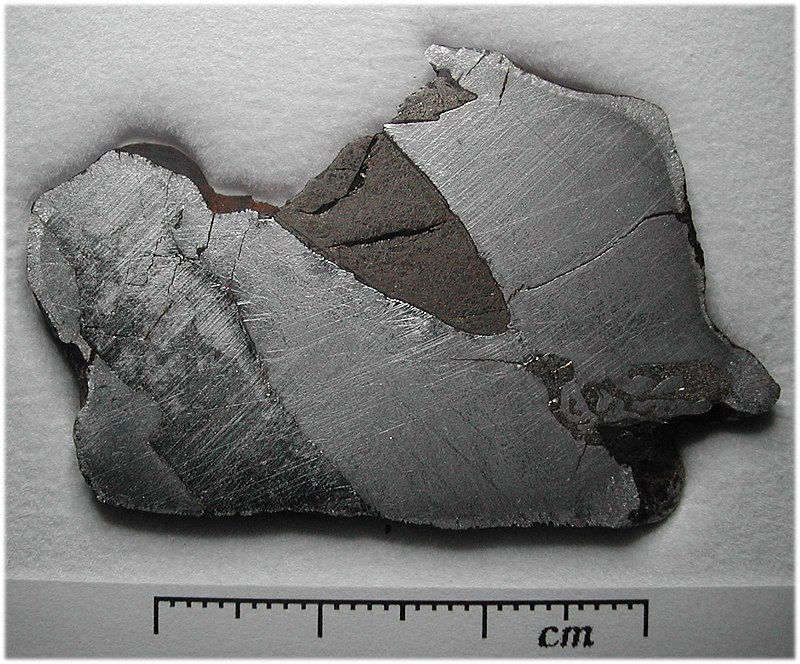
Linee di Neumann /Neumann lines LINK:https://it.wikipedia.org/wiki/Esaedrite#/media/File:Sikhote_alin.jpg
La classificazione delle meteoriti: si continua con le sideroliti
Le sideroliti, chiamati anche ferri rocciosi, sono rarissimi da trovare (a meno che non si siano visti cadere) per via della loro somiglianza alle rocce terrestri. Anche in questo caso, come le sideriti, abbiamo una tripla suddivisione:
PALLASITI
Hanno una matrice in ferro e nichel con grani di olivina
LODRANITI
Hanno un contenuto circa uguale di ferro e nichel e di silicati come olivina e pirosseni.
MESOSIDERITI
Hanno un contenuto circa uguale di ferro e nichel e di silicati come pirosseni e plagioclasi.
Meteorite classification: continue with siderolites
The siderolites, also called iron rocks, are very rare to find (unless they are seen to fall) because of their similarity to the terrestrial rocks. Also in this case, like the siderites, we have a triple subdivision:
PALLASITES
They have an iron and nickel matrix with olivine grains
LODRANITES
They have an approximately equal content of iron and nickel and silicates such as olivine and pyroxenes.
MESOSIDERITES
They have an approximately equal content of iron and nickel and silicates such as pyroxenes and plagioclases.
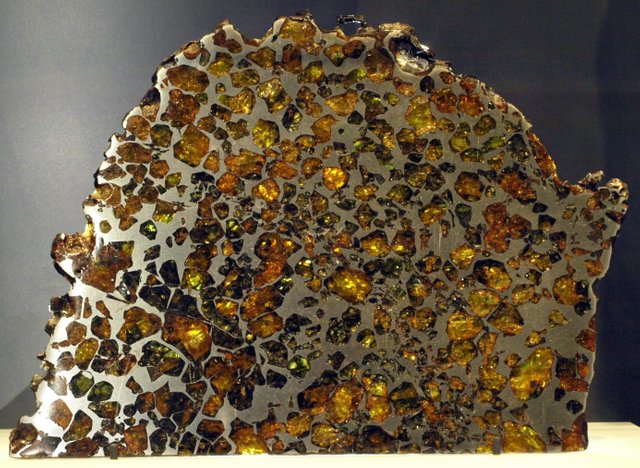
Pallasite/ Pallasites
LINK:https://upload.wikimedia.org/wikipedia/commons/a/ad/Pallasite-Esquel-RoyalOntarioMuseum-Jan18-09.jpg
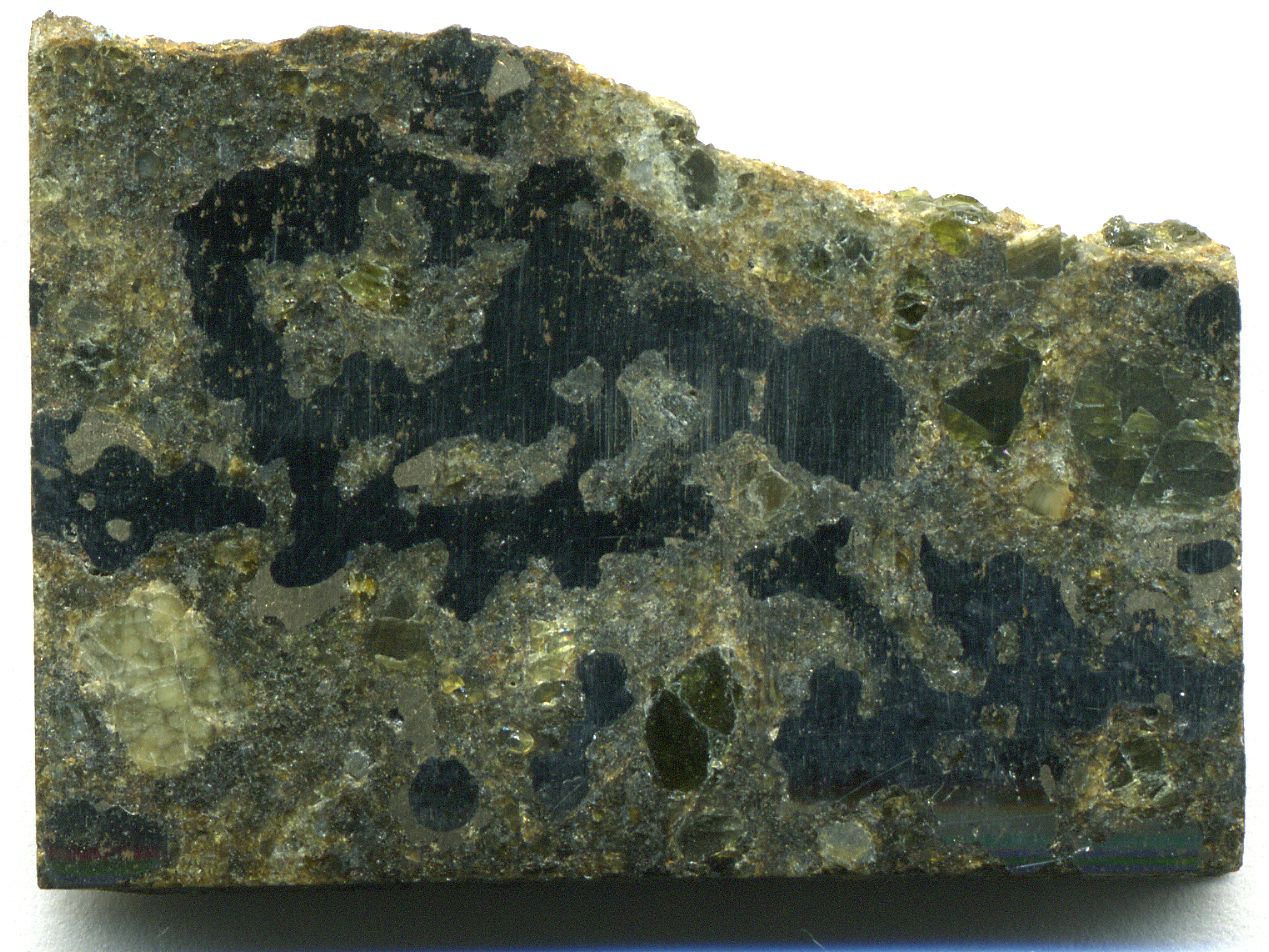
Mesosiderite /Mesosiderites LINK:https://upload.wikimedia.org/wikipedia/commons/a/aa/Estherville_meteorite%2C_mesosiderite_%2814609651640%29.jpg
La classificazione delle meteoriti: infine, ecco le aeroliti
Ultime, ma non meno importanti, sono le aeroliti. Le aeroliti sono sicuramente le meteoriti più abbondanti dato che risultano essere circa l'80% sul totale. Sono costituiti prevalentemente da silicati e sono molto simili, se non uguali, alle rocce del mantello terrestre. Anche le aeroliti hanno una suddivisione in classi, ma in questo caso dipende non tanto dalla composizione della roccia, ma dalla presenza o assenza di sferule chiamate condrule.
CONDRITI
Presenza di condrule, matrice lievemente ferrosa e di origine antichissima (4,2 miliardi di anni fa)
ACONDRITI
Assenza di condrule, nessuna matrice ferrosa e molto antica (1 miliardo di anni fa)
Nell'80 % del totale di aeroliti, le condriti sono circa il 90%, mentre le acondriti soltanto il 10%. Esistono anche rare condriti carbonatiche ricche di minerali idrati e con addirittura possibili composti organici.
Meteorite classification: finally, here are the aerolites
Last but not least, are the aerolites. Aerolites are certainly the most abundant meteorites, given that they are about 80% of the total. They consist mainly of silicates and are very similar, if not the same, to the rocks of the Earth's mantle. Also the aerolites have a subdivision into classes, but in this case it depends not so much on the composition of the rock, but on the presence or absence of spherules called condrule.
CHONDRITES
Presence of chondrules, slightly ferrous matrix and of very ancient origin (4.2 billion years ago)
ACHONDRITES
Absence of chondrules, no ferrous matrix and very old (1 billion years ago)
In 80% of the total aeroliths, the chondrites are about 90%, while the chondrites are only 10%. There are also rare carbonate chondrites rich in hydrated minerals and even possible organic compounds.
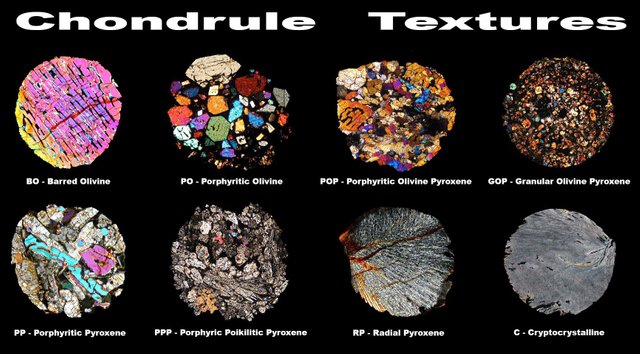 Tipi di condrule / Chondrule textures
Tipi di condrule / Chondrule textures LINK:https://upload.wikimedia.org/wikipedia/commons/7/76/Chondrule_Textures.jpg
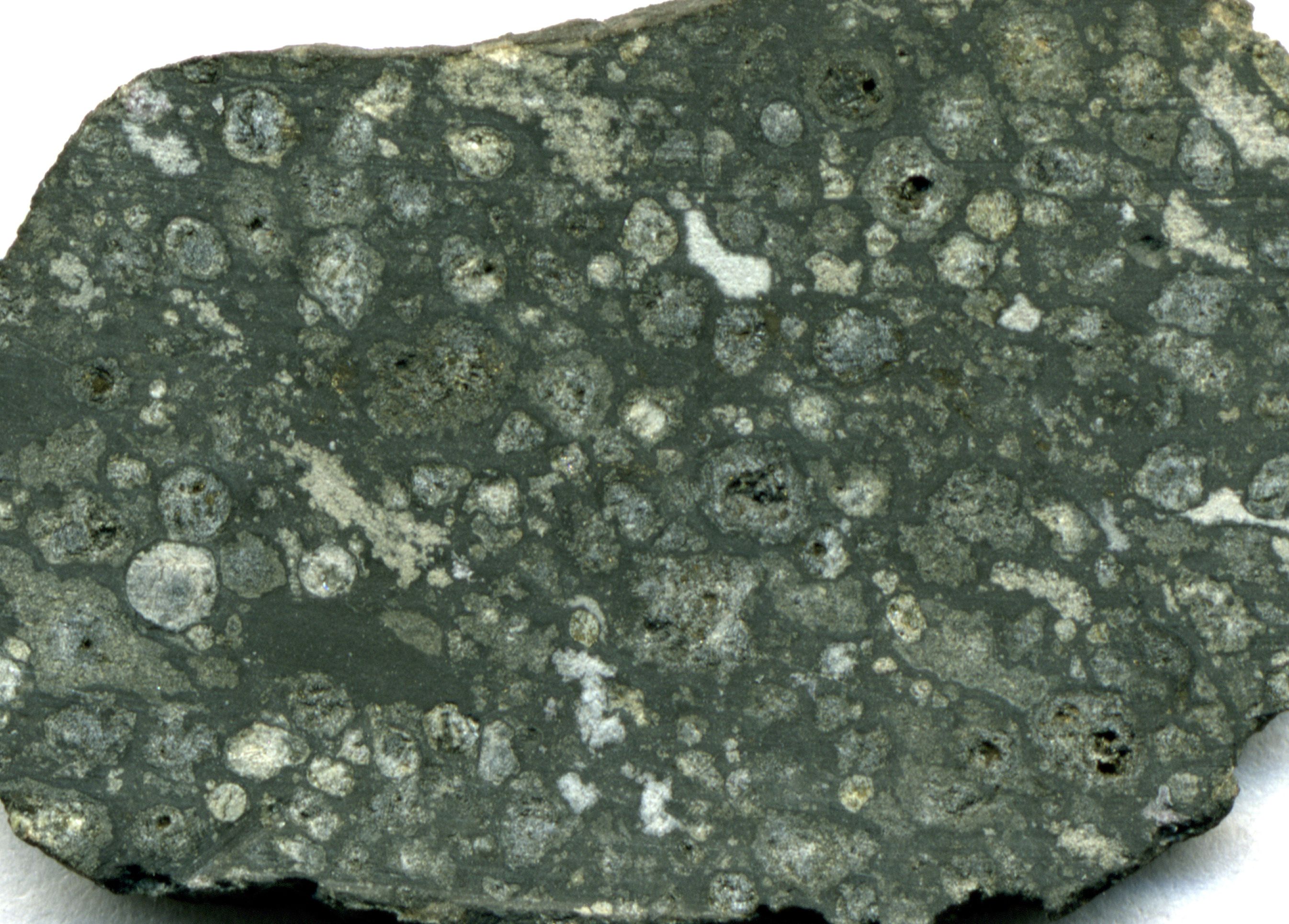 Condrite / Chondrite
Condrite / Chondrite LINK:https://upload.wikimedia.org/wikipedia/commons/4/4b/Allende_meteorite%2C_carbonaceous_chondrite_%2814601454299%29.jpg
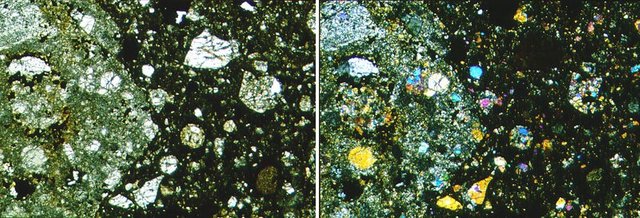
Aminoacidi in condriti / Amino acids in chondrites
LINK:https://astrobiology.nasa.gov/uploads/filer_public_thumbnails/filer_public/d1/f3/d1f3f7b8-dc30-4e94-8980-e2df472c9f24/pre95411-ppl.jpg__1240x510_q85_crop_subsampling-2.jpg
Queste che avete visto sono le classificazioni delle meteoriti. Lo sapevate che erano così tante? In ogni caso, prima di chiudere volevo parlarvi dell'ultima immagine che ho messo e di una cosa che mi disse un mio prof qualche anno fa ad una sua lezione. Quello che mi disse era che, secondo lui, la Terra non era molto diversa dalle meteoriti, specialmente dalle condriti. Se una condrite venisse fusa si avrebbe una parte minore di ferro liquido e una parte refrattaria silicatica. La Terra è composta al centro da ferro e nichel, come le sideriti, mentre la parte esterna, ad esempio il mantello e la crosta terreste, sono prevalentemente silicatici come la parte refrattaria delle condriti. Io non vedo tutta questa differenza. Cosa ne pensate? Infine, l'ultima immagine indica la presenza di aminoacidi in una condrite. Se c'è materia organica nello spazio, è possibile che la vita che noi conosciamo derivi da un meteorite caduto sulla Terra miliardi di anni fa? Ecco, volevo lasciarvi queste due domande. Non ho ulteriori conoscenze a riguardo, ma mi piacerebbe sapere cosa ne pensate qui nei commenti.
Vi ringrazio e mi auguro che vogliate lasciarmi anche un vostro upvote, invitandovi a farmi domande se ci sono cose poco chiare. Vi ringrazio per avermi letto e spero di ritrovarvi qui la prossima volta con i miei articoli :)
Vi ringrazio e mi auguro che vogliate lasciarmi anche un vostro upvote, invitandovi a farmi domande se ci sono cose poco chiare. Vi ringrazio per avermi letto e spero di ritrovarvi qui la prossima volta con i miei articoli :)
These are views are the classifications of meteorites. Did you know that they were so many? In any case, before closing I wanted to talk to you about the last image I put and something that told me one of my professor in one of his lessons. What he told me was, according to him, the Earth was not very different from the meteorites, from the chondrites. If a chondrite was melted there would be a minor part of liquid iron and a silicate refractory part. The Earth is composed in the center of iron and nichel, like the siderites, while the outer part, for example the mantle and the earth's crust, are mainly silicate like the refractory part of the chondrites. I do not see all this difference. What do you think? Finally, the last image indicates the presence of amino acids in a chondrite. Is it organic matter in space, is it possible that the life we know comes from a meteorite that fell to the earth billions of years ago? Here, I wanted to leave you these two questions. I have no further information about it, but I'd like to know what you think in the comments.
I thank you and I hope you also want to leave me your upvote, inviting you to ask me questions if there are unclear things.
Thank you for reading and I hope to meet you here next time with my articles :)
I thank you and I hope you also want to leave me your upvote, inviting you to ask me questions if there are unclear things.
Thank you for reading and I hope to meet you here next time with my articles :)
Bibliografia e approfondimenti / Bibliography and insights
Amino acids in chondrites (link eng)https://astrobiology.nasa.gov/news/amino-acids-in-chondrites/
Classificazione delle meteoriti (link ita)
http://archive.oapd.inaf.it/meteoriti.html/cap6.htm
Classification of iron meteorites (link eng)
https://www.higp.hawaii.edu/~escott/Scott%20n%20Wasson%201976%20rev%20irons.pdf
Classification of meteorites (link eng)
https://geology.com/meteorites/meteorite-types-and-classification.shtml


You received a 10.0% upvote since you are not yet a member of geopolis.
To read more about us and what we do, click here.
https://steemit.com/geopolis/@geopolis/geopolis-the-community-for-global-sciences-update-3
If you do not want us to upvote and comment on your posts concerning earth and earth sciences, please reply stop to this comment and we will no longer bother you with our love ❤️
Downvoting a post can decrease pending rewards and make it less visible. Common reasons:
Submit
Interessante, lo propongo a steemstem
Downvoting a post can decrease pending rewards and make it less visible. Common reasons:
Submit
Grazie ^^
Downvoting a post can decrease pending rewards and make it less visible. Common reasons:
Submit
Non so se ho capito bene: nelle acondriti davvero ci possono essere tracce di depositi organici?
Downvoting a post can decrease pending rewards and make it less visible. Common reasons:
Submit
Hai capito bene ^^ Sono stati trovati composti organici.
Downvoting a post can decrease pending rewards and make it less visible. Common reasons:
Submit
wow...davvero affascinante! Non ne sapevo quasi nulla...io qui a esprimere semplici desideri :) Cmq questa storia degli amminoacidi è davvero interessante, un nuovo spunto per chi è alla disperata ricerca dell'inizio :)
Downvoting a post can decrease pending rewards and make it less visible. Common reasons:
Submit
Infatti :) chissà se un giorno scopriremo qualcosa in più ^^
Downvoting a post can decrease pending rewards and make it less visible. Common reasons:
Submit
Quanti ce ne sono. Molto interessante. Ma la materia organica trovata in cosa consiste? C'è qualche similitudine con le forme di vita terrestri?
Downvoting a post can decrease pending rewards and make it less visible. Common reasons:
Submit
No, principalmente in elementi costituenti di proteine
Downvoting a post can decrease pending rewards and make it less visible. Common reasons:
Submit
No, non credo ci siano vere e proprie similitudini. Diciamo peró che c'é qualche traccia di qualcosa che c'é anche sulla Terra :)
Downvoting a post can decrease pending rewards and make it less visible. Common reasons:
Submit
Cioè in pratica sono sassi !
scherzo eh....,
interessante articolo
la Pallasite mi piace molto, mi ricorda l'ambra (che immagino siano i grani di olivina, giusto?)
Downvoting a post can decrease pending rewards and make it less visible. Common reasons:
Submit
Sono bei sassi, per essere corretti XD
Sì, sembra ambra, ma come giustamente hai detto, probabilmente è olivina :)
Downvoting a post can decrease pending rewards and make it less visible. Common reasons:
Submit
Wow, molto interessante e complimenti per il doppio lavoro (ita-eng). Bravo!
Downvoting a post can decrease pending rewards and make it less visible. Common reasons:
Submit
Grazie tante! Il doppio lavoro è lungo, ma ne vale la pena :)
Downvoting a post can decrease pending rewards and make it less visible. Common reasons:
Submit
Ottima spiegazione, molto divulgativo come al solito.
Downvoting a post can decrease pending rewards and make it less visible. Common reasons:
Submit
Grazie :)
Downvoting a post can decrease pending rewards and make it less visible. Common reasons:
Submit